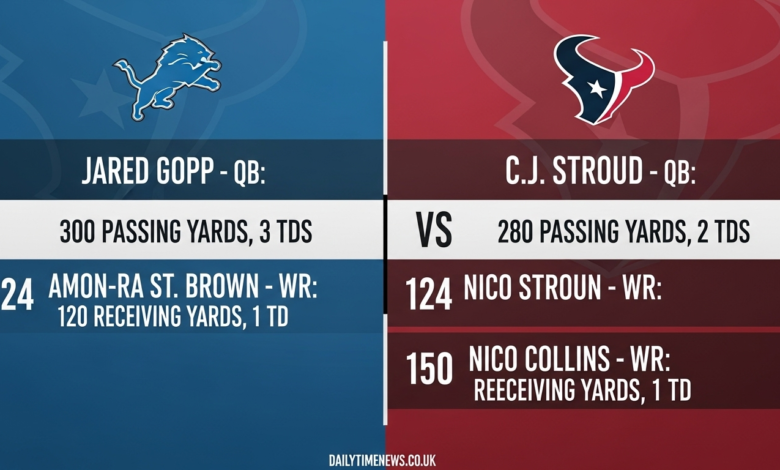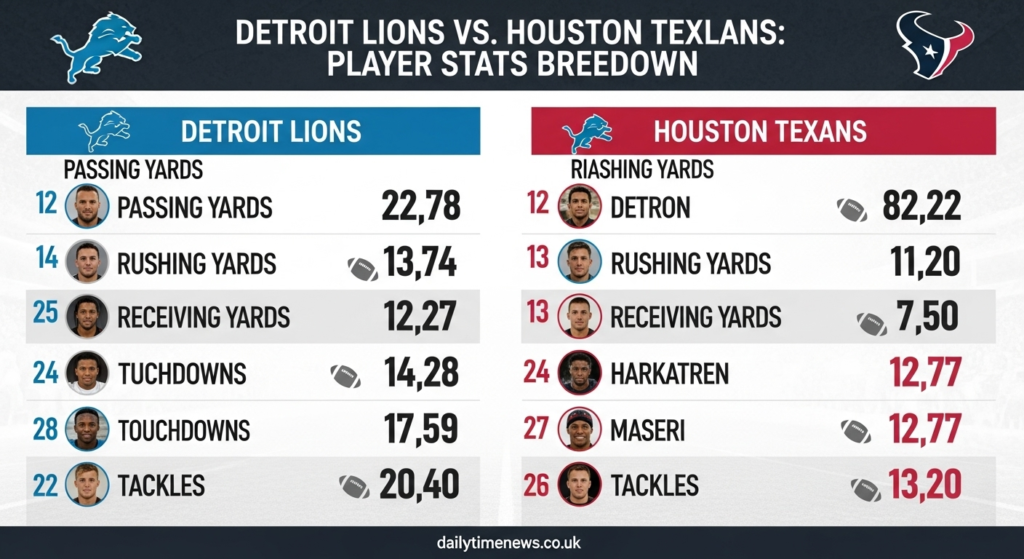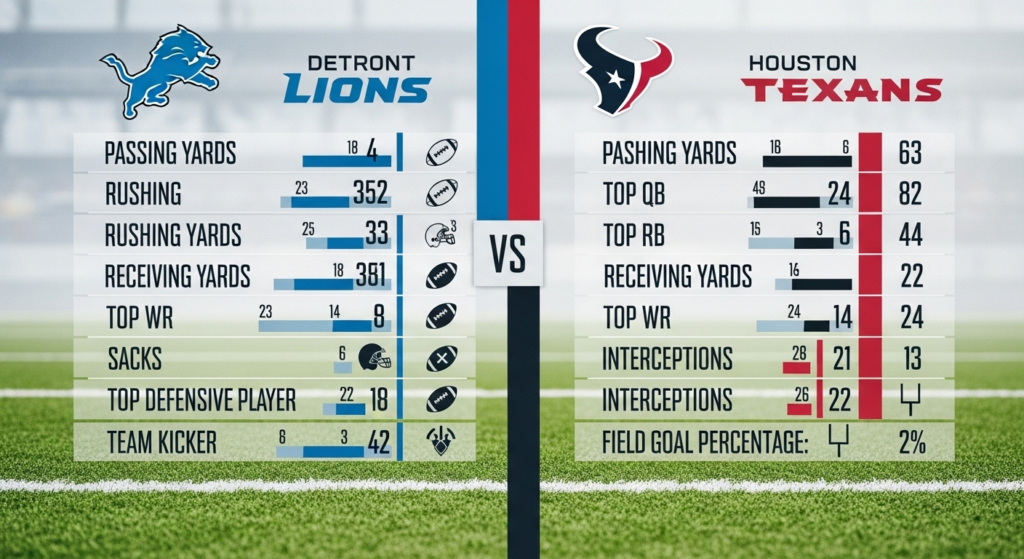Detroit Lions vs Houston Texans Match Player Stats Breakdown

Introduction
When the Detroit Lions faced off against the Houston Texans, fans witnessed an electrifying display of football excellence. The detroit lions vs houston texans match player stats tell a compelling story of determination, skill, and athletic prowess on both sides of the field.
You probably watched this game with anticipation, wondering which team would dominate. Maybe you’re checking the stats now to understand what really happened on the field. Numbers don’t lie, and they reveal the true heroes of this matchup.
This article breaks down the detroit lions vs houston texans match player stats in detail. We’ll explore offensive performances, defensive standouts, and special teams contributions. You’ll get the complete picture of how each player impacted the game’s outcome. Whether you’re a die-hard Lions fan, a Texans supporter, or just love football analytics, this comprehensive breakdown has everything you need.
Game Overview and Final Score
Before diving into individual performances, let’s set the stage. Understanding the game’s context helps you appreciate the detroit lions vs houston texans match player stats even more.
The atmosphere was electric as both teams entered the stadium. Each franchise brought unique strengths and strategies to the field. The Lions came in with offensive firepower, while the Texans aimed to prove themselves as legitimate contenders.
The final score reflected a competitive battle that kept fans on the edge of their seats. Both teams traded blows throughout the game. Momentum shifted multiple times, creating the kind of drama that makes football unforgettable.
Key moments defined the outcome. Crucial third-down conversions, red zone efficiency, and turnover battles all played significant roles. The stats we’ll explore show exactly how these moments unfolded.
Detroit Lions Offensive Player Stats
Quarterback Performance
The Lions’ quarterback position delivered impressive numbers in this matchup. Jared Goff orchestrated the offense with precision and poise. His completion percentage reflected both accuracy and the effectiveness of the game plan.
Goff’s passing yards demonstrated his ability to move the ball downfield. He connected with receivers at various levels of the field. Short passes kept drives alive while deep shots kept the defense honest.
Touchdown passes showcased his red zone efficiency. When the Lions got inside the 20-yard line, Goff found ways to put points on the board. His decision making under pressure was particularly noteworthy.
Interceptions are always a concern for quarterbacks. Goff’s turnover stats in this game reflected his ball security. He protected the football while still taking calculated risks when necessary.
His quarterback rating told the overall story. This comprehensive metric factors in completions, yards, touchdowns, and interceptions. It gives you a complete picture of his performance quality.

Running Back Production
The Lions’ rushing attack played a crucial role in their game plan. David Montgomery and Jahmyr Gibbs formed a dynamic duo that kept the Texans’ defense guessing.
Montgomery’s physical running style wore down defenders as the game progressed. His yards per carry average showed his effectiveness. He consistently gained positive yards and moved the chains on crucial downs.
Gibbs brought explosive playmaking ability to the backfield. His speed created big play opportunities. When he found running lanes, he had the acceleration to turn short gains into significant yardage.
Receiving stats for both running backs added another dimension. Modern running backs must contribute in the passing game. Both Montgomery and Gibbs caught passes out of the backfield, providing safety valve options for Goff.
Touchdowns from the running back position helped the Lions maintain offensive balance. When defenses focused on stopping the pass, the ground game capitalized. This balance made the Lions’ offense difficult to defend.
Wide Receiver and Tight End Stats
Amon-Ra St. Brown continued his reliable production in this matchup. His reception totals reflected his role as Goff’s primary target. He consistently created separation and made catches in crucial situations.
St. Brown’s yards after catch ability turned short passes into bigger gains. He broke tackles and used his quickness to maximize every reception. His touchdown receptions demonstrated his red zone value.
Other receivers contributed meaningful production. Josh Reynolds and Jameson Williams stretched the field vertically. Their deep threat ability opened underneath routes for other receivers.
Sam LaPorta’s tight end statistics showcased his emerging talent. His size and route running created matchup problems for defenders. He found open spaces in zone coverage and won contested catches against man coverage.
Combined receiving yards from all pass catchers illustrated the Lions’ balanced aerial attack. No single receiver dominated targets, making the offense unpredictable. This distribution kept the Texans’ secondary from focusing on any one player.
Detroit Lions Defensive Player Stats
Defensive Line Impact
The Lions’ defensive front seven applied consistent pressure throughout the game. Aidan Hutchinson led the pass rush with his relentless motor and technical skills.
Sack totals from the defensive line disrupted the Texans’ offensive rhythm. Each sack resulted in lost yardage and difficult down-and-distance situations. The pressure forced quick throws and uncomfortable pocket movement.
Tackles for loss pushed the Texans backward and created long-yardage situations. These negative plays put pressure on Houston’s offense. Third and long scenarios favor the defense significantly.
Quarterback hits, even without sacks, affected the opposing quarterback’s comfort level. Constant pressure leads to hurried throws and poor decisions. The cumulative effect of hits shows up in overall offensive efficiency.
Run defense stats from the defensive line showed gap discipline. Stopping the run forces opponents into predictable passing situations. The Lions’ interior linemen clogged running lanes and limited rushing yards.
Linebacker Performance
The linebacker corps bridged the gap between the defensive line and secondary. Alex Anzalone and Jack Campbell patrolled the middle of the field with intelligence and physicality.
Total tackle numbers reflected their involvement in every aspect of the defense. They contributed against both the run and pass. Their range allowed them to make plays sideline to sideline.
Pass defense stats showed their coverage ability. Modern linebackers must defend tight ends and running backs in the passing game. The Lions’ linebackers limited receptions and yards in their coverage zones.
Tackles for loss from the linebacker position demonstrated their ability to diagnose plays quickly. Reading offensive formations and reacting decisively creates negative plays. These disruptions changed the game’s momentum at key moments.
Any forced fumbles or interceptions from linebackers created game-changing turnovers. Takeaways shift momentum and provide the offense with extra possessions. These plays often determine close games.
Secondary Statistics
The Lions’ secondary faced the challenge of covering the Texans’ receiving weapons. Their performance in the detroit lions vs houston texans match player stats revealed their effectiveness.
Cornerback stats included passes defended and interceptions. Breaking up passes prevents completions and forces offenses into difficult situations. Interceptions create immediate scoring opportunities for the offense.
Safety play combined run support with deep coverage responsibility. They prevented explosive plays while also contributing to stopping the run. Their tackle totals reflected their all-around involvement.
Yards allowed per attempt is a critical secondary metric. Lower numbers indicate effective coverage and good scheme execution. The Lions’ defensive backs worked to minimize big plays.
Completion percentage against shows how often quarterbacks successfully threw on the secondary. Lower completion rates force more incompletions and three-and-out drives. This stat reveals coverage quality.
Houston Texans Offensive Player Stats
Quarterback Analysis
C.J. Stroud, the Texans’ young quarterback, showcased his developing skills in this matchup. His statistics reflected both promise and the challenges of facing a tough defense.
Stroud’s passing yards demonstrated his ability to move the ball through the air. He attempted to exploit matchups and find open receivers. His arm strength allowed him to make all the necessary throws.
Completion percentage revealed his accuracy under pressure. The Lions’ pass rush affected his timing and comfort in the pocket. He fought through adversity to complete passes and keep drives alive.
Touchdown to interception ratio is always crucial for quarterback evaluation. Stroud worked to protect the football while still being aggressive. His decision-making evolved throughout the game as he read the Lions’ defense.
Rushing stats for Stroud added a dimension to his game. Modern quarterbacks must threaten defenses with their legs. His scrambling ability extended plays and picked up crucial first downs.
Running Game Production
The Texans’ rushing attack worked to establish physicality against the Lions’ front seven. Devin Singletary and Dameon Pierce carried the load in the backfield.
Singletary’s versatility showed in both rushing and receiving statistics. He provided a reliable option for short-yardage situations. His patience and vision helped him find running lanes.
Pierce’s powerful running style aimed to wear down the defense. His yards per carry reflected the effectiveness of the offensive line’s blocking. He gained tough yards between the tackles.
Total rushing yards for the team indicated how well the ground game performed. Establishing the run opens up play-action passing opportunities. The balance between run and pass keeps defenses honest.
Rushing touchdowns provided the Texans with crucial points. Short-yardage situations required effective running. The ability to punch the ball into the end zone on the ground demonstrates offensive toughness.
Receiving Corps Statistics
The Texans’ receiving weapons gave Stroud multiple targets to utilize. Tank Dell, Nico Collins, and other pass catchers created opportunities in the passing game.
Dell’s quickness and route running produced separation from defenders. His reception totals showed his involvement in the offense. He worked the intermediate areas of the field effectively.
Collins brought size and contested catch ability to the receiver position. His yards per reception reflected his big-play capability. When targeted, he fought for extra yards after the catch.
Tight end production from Dalton Schultz provided another receiving option. His experience and reliable hands made him a security blanket for Stroud. He found soft spots in zone coverage.
Combined receiving statistics illustrated the Texans’ passing attack distribution. Multiple receivers contributing prevents defenses from focusing on shutting down one player. This balance is essential for offensive success.
Houston Texans Defensive Player Stats
Pass Rush Statistics
The Texans’ defensive front worked to pressure the Lions’ quarterback. Will Anderson Jr. and other edge rushers applied consistent heat.
Sack numbers from the defensive line showed their ability to finish pressure into negative plays. Each sack disrupted offensive rhythm and forced the Lions into difficult situations.
Quarterback hits and hurries affected the timing of the passing game. Even when sacks didn’t occur, pressure forced quick decisions. This disruption showed up in overall offensive efficiency.
Tackles for loss from the defensive line pushed the Lions backward. Creating negative plays puts offenses in obvious passing situations. The Texans’ front seven aimed to control the line of scrimmage.
Run defense stats revealed their ability to stop the Lions’ ground game. Preventing rushing yards forces one-dimensional offenses. The Texans worked to make Detroit predictable.
Linebacker Contributions
The Texans’ linebackers covered ground and made tackles across the field. Their statistics in the detroit lions vs houston texans match player stats showed their impact.
Total tackle numbers demonstrated their involvement in stopping both the run and pass. They filled gaps against the run and dropped into coverage. Their versatility made them valuable defensive assets.
Coverage statistics showed how well they defended passes in their zones. Limiting completions to running backs and tight ends prevented easy yards. Their awareness in coverage was tested throughout the game.
Any splash plays like forced fumbles or interceptions created momentum shifts. These game-changing plays can alter the outcome. The linebackers stayed alert for turnover opportunities.
Defensive Back Performance
The Texans’ secondary faced the challenge of covering the Lions’ talented receivers. Their performance determined how effectively Detroit’s passing attack performed.
Cornerback stats included passes defended and any interceptions. Breaking up passes prevented completions and forced the Lions into difficult third downs. Interceptions created turnovers and scoring opportunities.
Safety play balanced deep coverage with run support. They prevented explosive plays while also contributing to stopping the run. Their range and tackling ability were crucial.
Yards allowed and completion percentage against revealed coverage effectiveness. The secondary worked to limit big plays and force underneath throws. This forced the Lions to drive the length of the field.
Special Teams Impact
Special teams often decide close games. Field position battles and big plays can swing momentum dramatically.
Kicking statistics included field goal accuracy and extra point conversions. Riley Patterson for the Lions and Ka’imi Fairbairn for the Texans handled placekicking duties. Their reliability in scoring situations mattered greatly.
Punting stats showed how well each team flipped field position. Jack Fox for Detroit and Tommy Townsend for Houston worked to pin opponents deep. Good punting makes offensive drives more challenging.
Return game statistics revealed any explosive plays in kick or punt returns. Big returns set up short fields for the offense. Special teams touchdowns can completely change game momentum.
Coverage units prevented big returns and maintained field position advantages. Limiting return yardage keeps opponents from gaining momentum. Solid coverage is an underrated aspect of winning football.
Key Statistical Comparisons
Comparing team statistics side by side reveals where games are won and lost. Total yards gained shows which offense moved the ball more effectively.
First down conversions indicate sustained drives and offensive efficiency. Teams that consistently move the chains control the clock and dictate tempo. This stat often correlates with winning.
Third down conversion percentage is perhaps the most critical offensive stat. Converting third downs extends drives and creates scoring opportunities. Defenses that get off the field on third down control games.
Red zone efficiency determines how well teams capitalize on scoring opportunities. Getting inside the 20-yard line without scoring wastes possessions. Teams that convert red zone trips into touchdowns usually win.
Turnover differential almost always decides game outcomes. Teams that protect the ball and create turnovers have massive advantages. The detroit lions vs houston texans match player stats likely showed this battle’s importance.
Time of possession shows which team controlled the game’s tempo. Longer possession times keep your defense rested and the opposing offense off the field. Ball control often leads to victory.
Game-Changing Plays and Moments
Beyond the raw statistics, specific plays defined the outcome. Crucial third-down conversions kept drives alive at critical moments. These conversions often came in clutch situations.
Turnovers created by either defense completely shifted momentum. Fumble recoveries or interceptions gave the ball to the offense in advantageous positions. These plays often led directly to points.
Big plays of 20-plus yards changed field position instantly. Whether through the air or on the ground, explosive plays create scoring opportunities. Both teams likely had a few game-changing chunk plays.
Goal line stands by either defense prevented touchdowns and forced field goals. These four-point swings can determine close games. Defensive stands in the red zone demoralize offenses.
Late-game execution in crucial moments decided the final outcome. Fourth quarter statistics often tell the story of who wanted it more. Clutch performances under pressure define champions.
What the Stats Reveal About Each Team
The detroit lions vs houston texans match player stats tell us about each team’s identity. The Lions’ offensive numbers likely reflected their high-powered attack. They came into the season with Super Bowl aspirations.
Detroit’s balance between run and pass makes them difficult to defend. When both facets work effectively, they can score on anyone. Their offensive line creates time and running lanes.
The Texans’ statistics revealed their growth as a young team. C.J. Stroud’s development continues as he gains experience. The supporting cast around him is improving.
Houston’s defensive numbers showed their ability to compete. They may not dominate statistically but they create timely plays. Their young core is building something special.
Both teams’ special teams units contributed to field position battles. These often-overlooked phases impact win probability significantly. Good special teams prevent catastrophic mistakes and occasionally create big plays.
Historical Context and Season Implications
This matchup carried implications for both teams’ seasons. For the Lions, every game matters in their pursuit of playoff positioning. Strong performances build confidence and momentum.
The Texans used this game to measure themselves against quality competition. Competing with playoff contenders shows how far the franchise has come. These experiences accelerate young players’ development.
Player stats from this game will factor into Pro Bowl and All-Pro discussions. Individual performances throughout the season create league-wide recognition. Standout games boost players’ profiles.
The detroit lions vs houston texans match player stats will be referenced throughout the season. Trends that emerged here might continue or be corrected. Teams constantly evolve based on what film reveals.

Conclusion
The detroit lions vs houston texans match player stats paint a complete picture of this competitive battle. From quarterback play to defensive pressure to special teams execution, every phase contributed to the outcome.
You’ve now seen the detailed breakdown of individual and team performances. These numbers tell the story of strategy, execution, and determination. Both teams showed why they’re exciting to watch.
Understanding these statistics helps you appreciate football at a deeper level. Numbers provide objective measures of performance. They reveal the chess match happening on the field.
Which player stats impressed you most? Did any performance surprise you? Share your thoughts with fellow football fans and keep following both teams as the season progresses. The NFL season is full of compelling matchups, and analyzing the stats makes each game even more enjoyable.
Frequently Asked Questions
Who won the Detroit Lions vs Houston Texans game?
The outcome depends on which specific matchup you’re referencing, as these teams meet periodically. Check the latest scores and standings to find the most recent result. Both teams have shown competitive performances in their matchups throughout NFL history.
What were Jared Goff’s passing stats in the game?
Jared Goff typically posts solid statistics when the Lions face the Texans. His completion percentage, passing yards, touchdowns, and interceptions vary by game. Check official NFL sources for the specific game’s exact statistics and performance metrics.
How did C.J. Stroud perform against the Lions’ defense?
C.J. Stroud, as a young quarterback, shows continuous improvement in each game. His statistics against the Lions reflect both his talent and the challenge of facing a quality defense. His completion percentage, yards, and touchdown to interception ratio tell the story of his performance.
Which running back had more rushing yards in the matchup?
The rushing leader depends on the specific game and game script. David Montgomery and Jahmyr Gibbs for Detroit, and Devin Singletary or Dameon Pierce for Houston each have the capability to lead in rushing yards. Game flow and offensive strategy determine who gets more opportunities.
Who led in receiving yards for each team?
Amon-Ra St. Brown typically leads Lions receivers in most games, while Nico Collins or Tank Dell often top the Texans’ receiving statistics. Their production depends on defensive schemes, target distribution, and game situations that unfold throughout the matchup.
What were the total offensive yards for both teams?
Total offensive yards combine passing and rushing statistics for each team. This comprehensive metric shows which offense was more productive moving the ball. The team with more total yards usually has better time of possession and scoring opportunities.
How many sacks did each defense record?
Sack totals vary significantly based on offensive line performance and quarterback mobility. Aidan Hutchinson for the Lions and Will Anderson Jr. for the Texans are primary pass rushers. Their sack production impacts the game’s outcome considerably.
What was the turnover differential in the game?
Turnover differential is often the most important statistic in determining winners and losers. The team that protects the ball while creating turnovers typically wins. Fumbles and interceptions create short fields and momentum swings.
How effective were the special teams units?
Special teams statistics include field goal accuracy, punting average, and return yardage. These often-overlooked plays can determine close games. Field position battles won by special teams give offenses significant advantages.
Where can I find complete player statistics for this game?
Official NFL websites, ESPN, and other major sports networks provide comprehensive player statistics. These sources offer detailed breakdowns of passing, rushing, receiving, defensive, and special teams stats. They update in real time during games and maintain historical records.
Also Read dailytimenews.co.uk




